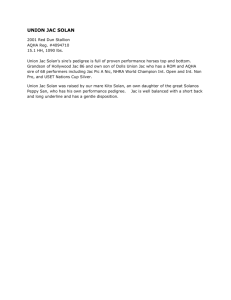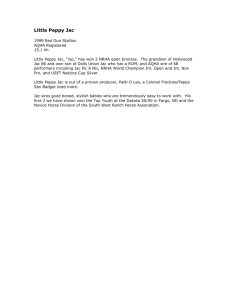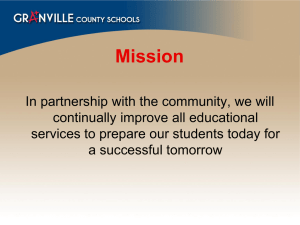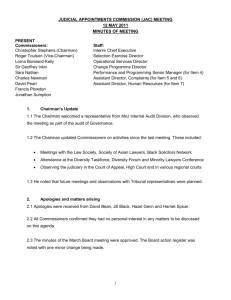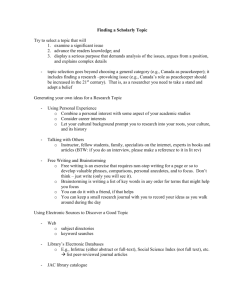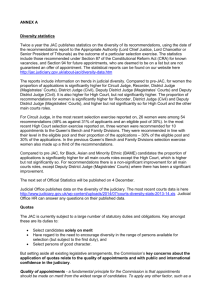Orientations Version 3
advertisement
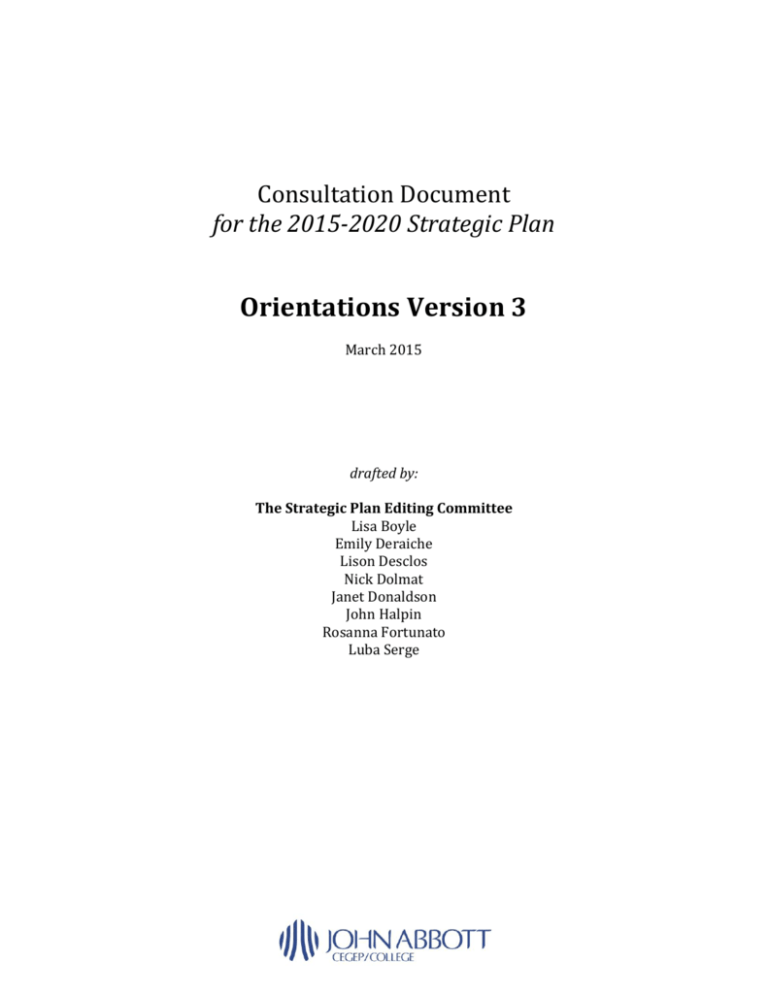
Consultation Document for the 2015-2020 Strategic Plan Orientations Version 3 March 2015 drafted by: The Strategic Plan Editing Committee Lisa Boyle Emily Deraiche Lison Desclos Nick Dolmat Janet Donaldson John Halpin Rosanna Fortunato Luba Serge What is this document? John Abbott College’s strategic plan for 2010-2015 will come to an end in June, 2015. The MESRS requires that the college develop a new strategic plan to cover the next 5-year period, from 2015 to 2020. This document is the 3rd step in our 6month consultation of the JAC community to define the strategic orientations that should be included in the 2015-2020 Strategic Plan. Version 1 of this document was distributed to the John Abbott community for consultation in November 2014. Suggested changes to Version 1 were received via e-mail, the Omnivox portal and at a Town Hall meeting in December. An editing committee (formed from representatives from SUJAC, JACFA, JACASPA, JACPA and JACMA) compiled all of the input into a Version 2 of this document, which was distributed for consultation in January 2015. Suggested changes to Version 2 were received via e-mail, and at a Town Hall meeting in February. The same editing committee again reviewed the input from the 2nd consultation phase to create this Version 3. What are Strategic Orientations? They are key activities that will help bring the college community to where we all hope to be in the year 2020. For simplicity, each orientation attempts to answer the following question: Imagine the year 2020, what differences will our students or staff see at JAC that will enhance student and institutional success? Trying to answer this question does not imply that JAC is presently in a critical or undesirable situation. To the contrary, the college overall is in an excellent position. However, the expectations of society and our students are continually changing, thus we need to try and prepare for the future rather than simply react to it. Version 2 of this document included 31 orientations. Of these orientations, 17 were grouped under the theme of Student Success, and 14 were categorized under the theme of Institutional Excellence. Key changes in Version 3 The 31 Orientations from Version 2 remained essentially unchanged, but Version 3 includes significantly more information attempting to clarify the intent of each orientation. As you will see, the editing committee worked hard to incorporate additional Clarifications, Possible Mechanisms, and Possible Measures in the table of orientations. The principle used by the editing committee was to capture the ideas in a consistent and neutral way. The objective was to avoid biasing the content for, or against, the intent of the orientation. 2 Some Additional Clarifications As with Phase 1, the editing committee tried to avoid repeating what was already captured in the Mission of the College. For completeness, the JAC Mission is included in Appendix A. To help focus the discussions, the editing committee also proposed the following clarifications. Student Success: In addition to the MESRS measures (pass-rates, retention rates, and graduation rates), our students need to be autonomous learners who are well prepared for, and enthusiastic about, their university or their technical career. (For additional details on the characteristics of a successful student, see the Mission of the College in Appendix A) Institutional Excellence: Although everything that is done at the college aims to enhance student success, the term “Institutional Excellence” was used to capture orientations that may be important but which were not as directly linked to the present academic life of the student (example: building renovations; professional development of staff; strong links to our alumni…). The Student Voice Through discussions with SUJAC, it was agreed that the students would hold an optional prioritization vote on the 17 “Student Success” Orientations. The results of this vote would be shared with the employees of JAC, prior to the final vote, in order to sensitize to community to what the students preferred. SUJAC wanted the students to participate in an influential manner, but not to participate in the final prioritization vote at the end of March. The students were able to consult Version 2 of this document and were asked to choose their 3 preferred orientations (in order of preference) in an Omnivox vote in mid-February. The responses were weighted by attributing 3-points to their 1st choice, 2 points to their 2nd choice and 1-point to their 3rd choice. Over one thousand students voted and the results of their vote are included in Appendix B. Your Role We ask you to review the 31 orientations in the table of orientations and to identify those that you prefer. You will be asked to choose 3 from the Student Success orientations (#301 to 317), and 3 from the Institutional Excellence orientations (# 318 to 331). It should be emphasized that you will be voting for the Orientation that you prefer. There may be Mechanisms or Measures that you do not agree with, and some may seem contradictory. The editing committee did not attempt to rationalize or prioritize them; they simply tried to neutrally capture all ideas. It is for that reason that they are called Possible Measures and Possible Mechanisms. Once the 3 Top-10 have been selected, the JAC community will have 5 years to assess which of the proposed mechanisms and measures are truly appropriate and effective. As has been said by many, the strategic orientations are merely a starting point, the real value and work is in how it gets implemented over the next 5-years. The Next Steps – Final Prioritization March 13 to 26 - Orientations Version 3 available for review March 26 to 29 - Omnivox vote of all JAC-employees to select Top-8 Orientations. Employees will be asked to choose their 3 preferred Student Success orientations and their 3 preferred Institutional Excellence orientations. As with the student vote, 3-points will be attributed to your 1st choice, 2 points to your 2nd choice and 1-point to your 3rd choice. Once the vote has been tallied, the top-5 Student Success orientations and the top-3 Institutional Excellence orientations will be kept. The Directors Team will then choose 2 final orientations to bring us to a final ten. Thank You Hopefully each member of the JAC community will see orientations that touch what they do every day, and thus suggest mechanisms and measures that relate to the area that they work in. We thank you in advance for your continued participation and truly hope that this process will help to strengthen our already excellent college. 4 APPENDIX A JAC MISSION Statement of Purpose The mission of John Abbott College is to provide an excellent education for our students within a stimulating learning environment that will enhance their development and potential for success in society. We are committed to: Learning • Foster in our students the ability to make and articulate informed intellectual, aesthetic and ethical decisions, while demonstrating skills needed for success in modern society. • Cultivate a love of learning, autonomy and responsible citizenship in our students, both in the classroom and through socio-cultural, leadership, recreational and sports activities. • Respect and learn from diverse world views and international perspectives, as reflected in our programs, our approach and our community. Quality • Provide well-rounded and balanced pre-university and career programs that meet high standards of quality and ethical consciousness, and respond to the requirements of universities, employers and society. • Value excellence in teaching and learning as dynamic and interactive processes. • Promote lifelong learning and continuous improvement in the College community, with a commitment to innovative pedagogy, effective administration and quality support services. • Deliver leading-edge training, tailored to the needs of business, industry and other sectors, through our continuing education services and specialized programs. Students • Cultivate a safe, caring and challenging learning environment that bolsters self-esteem and promotes a sense of belonging and purpose, mutual respect, and healthy lifestyles, leading students to attain academic, professional and personal success. • Ensure governance that reflects the active engagement of students, staff and faculty, and places students learning at the centre of our decisions and actions. • Establish effective partnerships with academic, professional and social communities, to maximize our students’ success and continued growth. 5 APPENDIX B 6 Orientations Version 3 No. ORIENTATION STUDENT SUCCESS - Student Engagement CLARIFICATIONS POSSIBLE MECHANISMS An ongoing process of analysis of drop-out rates triggers support service modifications and improved student retention. ● understanding of high dropout rates exist ● clearer links between support services and retention exist ● success rates are easily accessible and analyzed systematically ● action plans include clear & prioritized initiatives to improve retention ●breakdown data by programs and gender ● relate admission criteria to dropout rate ● identify groups that may be “at risk” ● relate retention graduation and success rates to “at risk” groups ● collect exit data from students ● retention rates & graduation rates Multiple engaging opportunities exist inside and outside the classroom and in the community that lend to the holistic development of our students. ● students acquire values, morals, sociocultural context, skills, ethical framework, active learning, build character and the ability to engage with communities, businesses and other social institutions ● the College promotes both curricular and extra-curricular activities for personal development, such as emotional intelligence, autonomy, perspective taking ethical responsibility, creativity, aesthetic perception, physical fitness sportsmanship and citizenship ● the college links curricular and extracurricular activities ● creation of competencies for larger world of community, service, work ● integrate student projects for credit with common college initiative (ex. 10K run with IT developing website, nursing first aid tent ) ● active learning ● integrate student projects with community based activities and initiatives ● number of initiatives ● number of students involved in initiatives 301 302 POSSIBLE MEASURES No. ORIENTATION Global citizenship is threaded throughout the curriculum and a wide range of opportunities for cross cultural exchange exist. 303 CLARIFICATIONS POSSIBLE MECHANISMS POSSIBLE MEASURES ● internationalisation is a Cegep wide objective and theme considered by all departments where appropriate ● reach out externally to various cultures ● intent is to provide global awareness and cross cultural knowledge ● profit and cost of international programs will need to be clarified ● cross-cultural includes “even in our country” ● establish common definition of internationalization ● emphasis on the creation of internships in foreign countries; travel abroad opportunities ● mobility mechanisms for all students at home and abroad ● local field trips, virtual tours and other opportunities to obtain global perspective even while remaining at home ● increase the number of inbound/outbound international student and faculty exchanges ● creation of joint projects with foreign educational institutions and businesses ● integration of international issues and concepts in courses, programs etc. ● information, support and opportunities are provided to faculty and staff ● increase the number of courses offered in foreign countries ● increased and improved support for and from the IPO ● establish an international certificate ● integration of international concepts in courses, programs etc; number of trips and initiatives ● cross cultural competencies exist ● number of students who graduate from programs with international content (or certificates) ● number of joint projects for intern/cultural ●number of courses with international component/content 8 No. 304 ORIENTATION CLARIFICATIONS POSSIBLE MECHANISMS POSSIBLE MEASURES All programs are designed, and continuously updated, to ensure that our students' knowledge and skills are aligned with the expectations of university and the world of work. ● students possess bilingualism (multilingualism) awareness of global perspectives and market place, IB programs ● alignment with program exit profiles/competencies ● emphasis on incorporating academic expertise in the curriculum ● keeping up to date with developing technologies, simulation software and IT ● JAC's technical program curriculum is well-aligned with future labour-market and licensing needs ● the college adapts to societal trends and expectations of the 21st century labour force ● mentorship programs; international programs; bilingual (multilingual) opportunities ● students are graduating with a level of information literacy that will support them. ● the JAC community is up to date with the changing world of technology and the surrounding culture. ● JAC programs include more opportunities for the application of knowledge for improved career choices (internships/mentoring/job shadowing) ● more conversations with universities vis-a-vis our student competencies ● survey grads to assess how prepared they felt for future studies ● consistent info literacy module/info session to all students through a required course ● providing support for simulation pedagogy – P.D. /funding/IT support ● JAC supports programs that facilitate critical thinking and a broad perspective on the world (not just technology) ● program assessments ● active advisory committees in tech. programs ● feedback from stage hosts ● more conversation /feedback from university professors ● number of contacts, frequency of meetings we now have with universities ● regular program assessment (could be partial assessments) ● results of student surveys 9 No. ORIENTATION CLARIFICATIONS POSSIBLE MEASURES JAC is a leader in education for aboriginal students and studies. ● in collaboration with First Nations leadership and in a setting that honours Aboriginal traditions. ● cultivate an environment that promotes openness and understanding of Aboriginal culture ● a range of effective support services for Aboriginal students ● a preparatory one-year college certificate for Aboriginal students from remote communities ● Aboriginal art works, plaques, and markers are placed throughout the college and its surroundings ● increased communication with First Nation school boards and communities ● strengthening of the links between John Abbott College and stakeholders (resource people) in First Nation communities ● strategies and programs to bridge the cultural gaps between Aboriginal and nonAboriginal students and staff ● an increasing number of students are graduating with the certificate in Aboriginal studies. ● students from remote communities are successful in their JAC programs because of the groundwork done in the preparatory oneyear certificate. ● retention : number of first national students returning for the second semester ● number of students completing a DEC/AEC at John Abbott College JAC programs include increased flexibility to accommodate diverse student realities. ● programs involve Day Division and Cont Ed (time of classes offered) ● flexibility includes flexibility of scheduling ● diverse student realities means social and economic challenges in pursuit of education ● more accessible education for adult learners ● increased offerings of smaller certificates ● five semester paths ● Pathways /Transition programs ● evening courses for Day courses and Day courses for Cont Ed ● E-Learning (mechanism & programs) are available ● programs to support adult learners with families ● modular AEC to DEC ● the number of new mechanisms that have been implemented ● the number of students using the new mechanisms ● constant monitoring via surveys 305 306 POSSIBLE MECHANISMS 10 No. ORIENTATION CLARIFICATIONS POSSIBLE MECHANISMS POSSIBLE MEASURES programs Pre-university and career programs continue to include strong General Education content. ● a high profile is given the role of General Education in all pre-university and career programs ● the college promotes curricular activities that improve capacities necessary for personal development, such as reading and writing, critical thinking, socio-cultural contextual thinking, perspective taking, emotional intelligence, autonomy, ethical responsibility, creativity, aesthetic perception, physical fitness, sportsmanship and citizenship ● each exit profile and comprehensive assessment inherently recognises the central role of General Education within that program ● JAC actively promotes, and provides support for research in reading and writing in English and French, independent critical thinking, healthy living and ethics across all disciplines and student support centres ● promote mutual understanding between General Education and programs ● enhance participation of General Education representatives within program committees ● Gen Ed hours in programs is maintained or increased JAC is a cultural hub and centre of Arts and Humanities. ● offering intellectual, historical, aesthetic, ethical, and global perspectives beyond the classroom. ● JAC offers a wide range of credit and non-credit courses for students of all ages ● JAC, including the library, is kept open after hours both for classes & activities ● open the library to the public which will generate money to extend library hours ● advertise to the John Abbott student population to draw them here ● publicize events through the Communications department ● create permanent exhibit ● JAC draws national and international figures who inspire day students and the greater West Island community ●The number of artistic/cultural events on campus 307 308 11 No. ORIENTATION CLARIFICATIONS POSSIBLE MECHANISMS POSSIBLE MEASURES areas ● create a “JAC Talks” lecture series to bring community to JAC and to export JAC into the community The College includes sustainable processes in all activities (educational, operational & administrative). ● sustainable operational and educational processes are understood by their administrators and governors ● the college includes environmental and energy considerations in all activities ● professional development ● IT investments ● sustainable practices in cleaning, energy and purchasing. ● share sourcing information for services and products (e.g. food, cleaning products etc.) ● available resources and professional development to encourage teaching about sustainability ● use of sustainable practices inside and outside the classroom ● waterless urinals ●Education - survey of student knowledge of sustainability issues ●Operations - waste/energy audits over time - life cycle analysis for products used (e.g. food, cleaning products - disposal or re-purposing) Borders between Continuing Education and Day Division are eliminated. ● this would facilitate access for students from all types of background ● there is an alignment of Day Division and Continuing Education administrative and pedagogical processes and approaches ● increase sharing and mentoring between Continuing Education teachers and Day Division teachers ● share best practices and up to date labour market information between the two divisions ● increase services for Continuing Education students, ● number of mechanisms implemented ● number of support services available to Continuing Education students 309 310 12 No. ORIENTATION CLARIFICATIONS POSSIBLE MECHANISMS POSSIBLE MEASURES matching those of Day Division; advising, counselling, study skills, Academic Success Centre, Library ● increase collaboration between divisions (e.g. Continuing Education professionals participate monthly in program meetings to discuss latest developments) ● Continuing Education management of stage module ● piloting online course delivery ● Continuing Education using innovative pedagogy used in the Day Division ● stronger links between Continuing Education programs and Program Deans ● full time status available to night students. ● French courses available to night students. ● allow day students access to night classes and vice-versa John Abbott is operating a successful Language School. 311 ● languages would/could include English, French, Spanish, Mandarin etc. for credit & non-credit, local and international students ● define target groups and clients (e.g. International students) ● the organizational structure of the school will need to be defined ● create links to the French and Language departments and the Academic Success Centre ● hire a consultant to research the following areas: market analysis, Continuing Education versus a separate Language School, marketing and international promotion ● profit ● enrolment ● student surveys 13 No. ORIENTATION CLARIFICATIONS POSSIBLE MECHANISMS POSSIBLE MEASURES Faculty is clearly engaged in the application of various pedagogical techniques including active learning, elearning and blended learning. ● E-learning should follow guidelines set at Academic Council ● the constraints of E-learning and Active learning will need to be addressed ● E-learning and Blended learning are only a subset of possible approaches The college continuously improves its pedagogy through: ● classroom design and AV/IT infrastructure support ● pedagogical techniques including Active learning ● E-learning and Blended learning ● supporting infrastructure that allows use of technology and support for faculty wanting to learn about interactive websites and other technology ● encourage pilot projects: faculty to put forward and work on new projects ● creating database of available technology and resource persons at the college ● survey students to see the effectiveness of use of technology vs. standard teaching methods ● increased number of courses that use new pedagogical techniques ● increased number of specialized spaces that support pedagogical innovation A full range of student support services continue to adapt to the increased demand and changing student needs. ● academic, personal and career needs are addressed ● a range of student support services which adapt to changing needs which may include linguistic, mental and physical health needs… ● all students and staff are well informed about available student support resources through a centralized location ● a College-wide network of clearly identifiable, trained staff exists to support and refer students with mental health difficulties ● High School guidance councillor input into student services provided ● a committee of representatives from support services and students as well as faculty to identify unmet needs ● measurement of use of student services (get a measure of demand) ● semester-end student survey/assessment of student services 312 313 14 No. ORIENTATION CLARIFICATIONS POSSIBLE MECHANISMS POSSIBLE MEASURES ● workshops and professional development activities to sensitize/train faculty and staff on student needs (e.g. mental health) All faculty and staff are effectively using institutional tools intended to support student success. ● Léa, gradebook etc ● awareness of the IPSEA exists across the entire JAC community. ● continuously upgrade/update tools ● regular sessions on IPESA for all new teachers & those wanting to refresh their knowledge ● a better communication between end users and system administrators ● ensure IT support for online tools ● sessions on how to effectively use the tools for teachers ● number of teachers using tools ● number of student complaints/concerns ● survey of students regarding effectiveness of tools such as LÉA Students and faculty have access to affordable classroom materials. ● including free resources and not for profit books ● faculty have access to free copies from the publisher ● bring awareness to teachers on their book selection ● online, e-books ● increase communication between teachers and publishers to create custom books which are generally less expensive and to have more resources ● Deans & Chairs should inform their departments of the total cost to student ● number of departments that have a cap on book value for sale ● number of partnerships with college press and publishers 314 315 15 No. ORIENTATION John Abbott is operating successful Learning Centres in all required locations. 316 JAC 's Data Mining office has solid databases, at all levels, to guide program evaluations & updates and to drive institutional decision making. 317 CLARIFICATIONS POSSIBLE MECHANISMS POSSIBLE MEASURES ● including peer tutoring centres, language centres ●the terms “successful” and “required” need to be clarified ● courses - i.e. Writing Tutors (English) ● learning Centres i.e. Math lab ● Student Success Centre -i.e. tutoring service, workshops etc. ● provide tutor training for peer tutors in all locations ● promotion of learning centres on campus ● student evaluation of learning centres ● number of learning centres operating on campus ● usage rate of learning centres on campus ● student success from preadmission to the beyond graduation stage ● strong culture of evaluation including improvements to the information systems and reporting on key indicators of students and institutional success ● ensure that data collected is analysed and utilised ● compilation of all data required by departments ● provide departments /programs with feedback about success/preparation of our students for the workforce/universities ● acquisition and use of available external databases such as CREPUQ (Conférence des ● number of programs / departments being provided with annual reports on their student success indicators ● number of workshops offered to provide assistance on the interpretation of these indicators ● number of attendees recteurs et des principaux des universités du Québec) ● use of pedagogical system to better predict the number of courses required (allocation 16 No. ORIENTATION CLARIFICATIONS POSSIBLE MECHANISMS POSSIBLE MEASURES etc.) ● integration of our local database, CLARA, in the pursuit of program assessment to complement the external databases already in full use at JAC INSTITUTIONAL EXCELLENCE - Faculty, Staff & Community Our strong alumni and retiree network is engaged in supporting our students, programs and community. 318 ● alumni include former students and retirees ● plan the events of the 50th anniversary reunion ● establishing an alumni association (student & retiree) ● social media mechanisms ● improve communication with alumni & retirees (advertise or contact them with upcoming events) ● the retiree association is active and involved in college life ● student alumni association exists ● the number of alumni and retirees are connected ● a number of events targeting specific groups (athletics, theatre, international, professional programs) and targeting outside of Montreal as well. ●number of events leading to the 50th anniversary reunion ● revenue generating /fundraising opportunities by alumni 17 No. ORIENTATION CLARIFICATIONS POSSIBLE MECHANISMS POSSIBLE MEASURES Strong partnerships exist between the college and the external community ● high schools for recruitment and student success ● businesses for internships, experiential learning, career awareness, fundraising and scholarships ● community services and government agencies for student support and engagement ● collaboration with professional associations for curriculum alignment ● partnerships to include other institutions of higher education (Québec, Canada & world) ● scholarships to also include sponsorships ● external community is not limited to our neighbour (geography) i.e.: covers the world ● internship agreements ● increased scholarships ● clear flow of student support services from the college to external agencies ● articulation agreements ● memorandums of understanding with other institutions (abroad, local other colleges) ● setting up alliances with other institutions. ● jointly organized activities with municipalities, for fun and/or learning ● number of external community partnerships ● increase in the amounts of scholarships or number of scholarships/sponsorships ● increase in the number of opportunities (international, students, faculty) – exchange of teachers, budget permitting All employees are benefiting from the professional development (PD) that they require. ● a clear distinction is needed between required job training and PD ● available opportunities are easy to find ● employees understand what is available and how to get access ● annual Employee Assessments include clear professional development plans ● creation of workshops that are based on department or program needs. ● targeted advertising re: library documentation ● subscription to relevant training ● interactive approach to identify PD needs and PD activities ● survey to demonstrate that staff has received the required PD ● increased use of CLTRC documentation 319 320 18 No. ORIENTATION CLARIFICATIONS POSSIBLE MECHANISMS There exists a culture of multidisciplinary and multifunctional collaboration across the entire college community. ● establish increased awareness and sharing of best practices across the college. ● should help to reduce conflict and departmental “silos”. ● it should be noted that some effective cross-departmental activities already exist: Academic Council Board of Governors All Chairs Program committees College pedagogical days ● mentoring programs ● improved professional development ● communities of practice (like Active Learning) ● team teaching ● new collaboration mechanisms (office rotations, open house for staff, more celebrations…) ● Effective college-wide communication plan and processes ● increased crossdepartmental meet & greet functions ● may be facilitated through a universal break, common meeting time or more centralized scheduling ● improved conflict resolution mechanisms ● employee surveys show increased awareness of cross- departmental practices ● reduced number of grievances The College recruits a steady stream of qualified applicants from the West Island and beyond. ● the term “applicant” refers to potential future students in our Day sector and Continuing Education programs ● The intent is to ensure that JAC is not adversely affected by demographic drop in student population across the province ● recruitment may need to be across Canada and international ● effective recruitment tools and processes exist (promotional packages, videos…) ● offer an increased variety of course and programs (credit, non-credit, DEC, AEC, RAC) ● offer an increased variety of pedagogical delivery methods ● allow cross-discipline teaching ● integration of different demographics (i.e Education Center for seniors) ● comparing number of JAC applicants & registrants to provincial data ● number of healthy programs and offerings ● clearly defined data-based program needs (number of students) have been established 321 322 POSSIBLE MEASURES 19 No. ORIENTATION CLARIFICATIONS POSSIBLE MECHANISMS POSSIBLE MEASURES ● a clear international student recruitment policy is in place ● JAC is present at national and international recruitment fairs and conferences ● further leverage our beautiful campus, new Science building, our renovated campus JAC is a leader in pedagogical research, applied research and in the use of simulators 323 ● the College's mandate includes applied research via CCTTs and pedagogical research ● JAC is already a leader in simulation technology and we must remain at the forefront ● simulators and simulations are critical in our Nursing, Pre-Hospital Emergency Care, Police Technology programs and should be extended to many other programs ● targeted pedagogical training for instructors ● promotion of informed and innovative pedagogy ● JAC is strongly involved in a CCTT ● the development of a catalogue of grants & available funding sources ● increased promotion & awareness of research and role of CCTT’s ● communities of practice, knowledge-sharing and guest speakers for research ● a strategic needs-analysis to identify required research areas ● required mannequins, video replay capability, training and technical resources are in place ● appropriate simulation software and related infrastructure is in place ● the number of teachers involved in the MasterTeacher program ● the number of applications and successful grant requests ● number of programs with simulation based pedagogy ● number of “learning visits” to our simulation center from other colleges 20 No. ORIENTATION CLARIFICATIONS POSSIBLE MECHANISMS POSSIBLE MEASURES JAC has a world class IT infrastructure and technical support. ● Definitions: IT Infrastructure: All equipment and software in support of IT needs across the college World-Class Infrastructure: up to date with proven technology that is reliable, robust (low failure-rates), highly secure and affordable (within government allocations and laws) World-Class Technical Support: IT issues are able to be resolved quickly and in a timely manner ● BYOD, reliable WIFI, interactive applications ● classrooms have a flexible learning environment with full AV/IT capabilities and security features ● establish Key Performance Indicators (KPI’s) and standards of excellence based on industry standards for IT performance ● processes for system performance are in place ● an IT security and disaster recovery policy is in place (including contingency plans) ● Solid needs-assessment is in place (classrooms, BYOD, applications…) ● use of Cloud-based applications where appropriate ● mean-time to problem resolution (relative to agreed internal targets) ● number of classrooms that possess required AV/IT capabilities ● network is able to meet the bandwidth & BYOD needs ● defined KPI’s are being met The college has been completely and sustainably renovated. ● it is understood that the priority is to complete the learning areas (including the IT and security requirements). ● it is implied that it should be affordable and cost-effective ● the term “sustainable” implies the use of “green” products and processes that consider the cradle to grave implications ● increased study and classroom space (achieve MESRS norms) ● classroom security requirements and plan are in place ● increased number of staff working on renovation projects ● a revised renovation plan that has realistic (and experience based) timelines and costs ● JAC floor-space meets all MESRS norms (office space, classroom space…) ● a sustainable renovation and procurement policy is in place ● classroom security requirements are met ● 2-way security communication exits where required (classrooms, meeting rooms…) ● sustainability targets are being met ● 100% of study space has been renovated ● the 5-year renovation plan is completed 324 325 21 No. ORIENTATION CLARIFICATIONS POSSIBLE MECHANISMS POSSIBLE MEASURES ● increased equity in office space and access to cuttingedge classrooms JAC is a leading employer that attracts and retains the best faculty and staff. ● the term “best” implies that all required and desired employee qualifications are being met, and that a high percentage of 1st choice candidates (from selection committees) are accepting JAC employment offers ● retention rates and targets have been established ● effective recruitment tools and processes are in place ● extended orientation /handbook ● a variety of employee recognition and retention tools exist (exit surveys, suggestion box, incentives, participation in committees…) ● career path development tools (mentoring, counselling, skip-level meetings…) ● more options for part-time work and flexible hours ● development of a credible employee satisfaction survey ● retention/turnover targets are being met ● employee surveys show high job-satisfaction rates JAC is less vulnerable to government cut backs ● with increased government cutbacks, it is going to fall onto the ancillary services to make the money ● ancillary services revenues ● foundation capital campaign (for example, the Foundation Board can decide to run a capital campaign for the Library renovations.) ● representation at all government levels (through the Fédé) ● research contracts with private industry ● elimination of bureaucratic waste ● evaluate the feasibility of charging a reasonable fee for ● percentage of College revenues that are nongovernment 326 327 22 No. ORIENTATION CLARIFICATIONS POSSIBLE MECHANISMS POSSIBLE MEASURES course changes, partnership courses, etc. ● find other sources of ancillary funding like renting the cafeteria for weddings, banquets, etc. ● increase international revenue ● increased lobbying with government 328 329 More transparent and inclusive governance where all employees, faculty, and students participate in making decisions that affect them. ● governance is not only the internal community of the College but also external ● town hall/forum where the Board of Governors is present to communicate with the internal community ● more diverse membership on committees – engage more participants ● enhanced communication and consultation ● survey of all employees to measure the level of trust and transparency Organizational processes are more effective & efficient. ● elimination of bureaucratic waste ● automation of manual processes (without forgetting the human touch for balance) ● pre- and post- measures are established ● simplified expense reports and vacation/absence reporting ● electronic orders for the print room ● automatic itemized billing of expenses ● practices to reduce email overload ● quantity of hours saved ● reduced amount of repeated tasks 23 No. ORIENTATION CLARIFICATIONS POSSIBLE MECHANISMS POSSIBLE MEASURES JAC strongly values and promotes health and wellness for students and staff. ● health and wellness is deemed important to the College and its ability to meet its mission. ● development of policies supporting health and wellness: provide quality food and snacks on campus physical activities opportunities alignment with provincial and community campaigns ● College commitment to providing operational support (funding, facilities, access, supportive culture) for staff and students for health and wellness related initiatives ● clarify how Food Services could contribute in a healthy living context. ● campus-wide smoking ban ● improved ability to manage mental health issues ● harassment committee ● number of health-related events and participation rate ● reduction of sick time ● reduction of work-related stress leave ● development of healthy lifestyle habits John Abbott College is clearly positioned as the foremost English Cegep in Quebec. ● students and the community recognize JAC as the Cegep of choice based on the quality of pedagogy & student life ● this could be determined through surveys and increased numbers at open houses/applications, etc. ● surveys show that JAC is recognized as the "Cegep of choice" by students ● graduation rates ● admission rates to higher institution ● retention rates ● number of applicants 330 331 24
